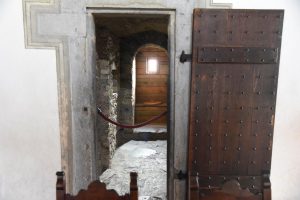After a week of touring ancient cities on the Rhine including visiting a good selection of castles, fortresses and churches, I discovered that I most enjoy them! They offer a complete glimpse into the way entire towns lived, the ways families came together and went about their daily lives, and how they protected their lives.
One thing that came as a surprise was this: All castles have a single weak spot. There was only one penetrable opening in the castle that put the inhabitants at risk of enemy takeover. And, it’s the one spot with direct and open access to the ground below. Any guesses where it is?
Because the toilet was a simple hole in the floor with direct access to the outside, usually on the second floor and located over a hill, it created a vulnerable spot for the fortress. For this reason, the toilet only locked on the outside so you could escape quickly and lock the enemy out, and, was located in a highly trafficked room such as a dining hall so that if the enemy came up, there were lots of knights waiting to attack them!
As I was learning about all the attempted attacks on the Marksburg Castle (the most well-restored castle on the Rhine), I got to thinking about sales teams. It struck me that all sales teams have a weak spot too. And while all teams might not have the exact same weak spot, identifying yours is the key to accelerating performance. In my experience, a sales team weak spot falls into 1 of 5 categories:
- Not customer success focused. If your team does not put the customer needs first, it creates a weak spot because the customer will leave to find someone that does. You can’t grow if your customer attrition is high.
- Limited lead attraction. If your team is not focused on finding and converting the right number of qualified leads, revenue will dry up.
- Absent growth culture, if your company is not focused on structuring and paying your team for growth, top performers will leave, and sales will evaporate.
- Lack of process. If your team does not follow an objective process that mirrors the customer’s buying cycle, you cannot repeat success.
- No performance culture. If your sales leadership does not monitor, measure, and coach your team weekly, they are creating a weak spot by enabling poor behavior.
The Marksburg Castle was never successfully taken, but not because it couldn’t be. There was a weak spot after all. It was never taken because the Castle inhabitants knew how to protect against the weak spot, mitigate against its risks, and shore up defences quickly should the enemy advance.
In business, there is no shame in having a weak spot. The shame is in not identifying it, mitigating the risks associated with it, and shoring up defences to ensure you can be successful despite your weak spots.


